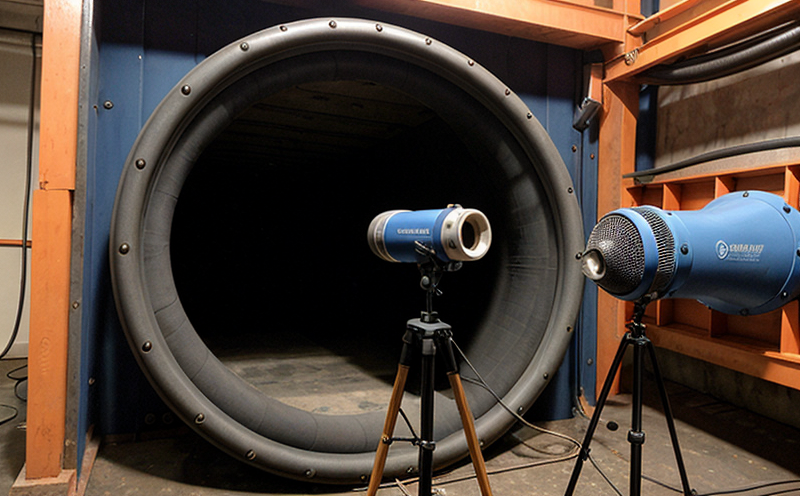ISO 16827 Ultrasonic Time-of-Flight Diffraction (TOFD) Testing
The ISO 16827 standard specifies a non-destructive testing method for the inspection of materials and components using ultrasonic time-of-flight diffraction (TOFD). This technique is particularly advantageous for the evaluation of large-welded joints, pipe welds, and complex geometries where conventional radiographic methods are either impractical or yield insufficient results. TOFD testing relies on a pair of transducers that emit and receive ultrasonic waves; one probe acts as the emitter while the other captures echoes from defects.
The method is based on the principle of diffraction of an ultrasonic beam around a defect in a material, which creates a detectable signal. The technique calculates defect depth by measuring the time it takes for sound to travel between the probes and reach the defect. The TOFD approach provides high sensitivity and resolution, making it ideal for detecting small flaws that might otherwise go undetected.
ISO 16827 ensures consistency in testing procedures and results across different laboratories and industries. This standard is widely adopted by manufacturers of pressure vessels, piping systems, and other critical structural components to ensure the integrity and reliability of their products. TOFD testing is particularly beneficial for sectors such as petrochemicals, aerospace, and nuclear energy where component failures could have catastrophic consequences.
Preparation for a TOFD test involves cleaning the surface area to be tested and ensuring that the material does not contain any external contamination or rust. The ultrasonic probes are then carefully positioned on either side of the weld joint or defect area. Calibration is critical; the probes must emit sound waves at precise angles and frequencies to ensure accurate measurements.
The test process involves scanning the component, typically in a linear fashion, while the probes move along it. During this scan, signals from potential defects are recorded, analyzed, and interpreted by trained technicians. The results provide detailed information about defect size, orientation, and location within the material. Reporting is comprehensive, detailing all detected flaws and their characteristics.
The implementation of ISO 16827 TOFD testing ensures compliance with international standards, enhancing trust among stakeholders. By adhering to this method, manufacturers can confidently demonstrate that their products meet stringent quality requirements, thereby increasing market competitiveness and customer satisfaction.
Industry Applications
The ISO 16827 TOFD testing is widely used in industries where the integrity of welded joints and components is critical. Key applications include:
- Petrochemical plants: Ensuring that pipes and vessels are free from defects to prevent leaks and explosions.
- Aerospace manufacturing: Detecting flaws in complex structures like turbine blades, engine casings, and fuselage parts.
- Nuclear power generation: Inspecting reactor components for wear and tear or potential failures due to radiation exposure.
- Oil & gas exploration: Evaluating the integrity of pipelines and storage tanks.
In each of these sectors, TOFD testing plays a crucial role in maintaining safety standards and operational efficiency. The method's ability to detect minute flaws without altering the component's structure makes it indispensable for ensuring long-term reliability.
Quality and Reliability Assurance
The ISO 16827 TOFD testing contributes significantly to quality assurance by providing a reliable means of detecting internal flaws in materials. This method ensures that components meet stringent requirements set forth by international standards, thereby enhancing the overall reliability of products.
One of the key advantages of TOFD is its high sensitivity and resolution, allowing for precise defect detection even in large structures like pipes or welds. The technique's ability to provide detailed information about the nature and extent of defects helps manufacturers implement corrective measures promptly, preventing potential failures.
The standardization provided by ISO 16827 ensures that tests are conducted consistently across different locations and facilities. This consistency is vital for maintaining a high level of quality assurance and reliability, as it allows for accurate comparisons between test results from various laboratories.
By adhering to this method, manufacturers can demonstrate their commitment to excellence in product integrity, which in turn builds trust with customers and regulatory bodies. The comprehensive reporting provided by TOFD testing supports decision-making processes related to component replacement or repair, ensuring that only necessary actions are taken based on accurate data.
Competitive Advantage and Market Impact
Incorporating ISO 16827 TOFD testing into a manufacturing process enhances product reliability and safety, leading to increased customer trust.
The ability to consistently detect internal flaws ensures compliance with international standards, thereby reducing the risk of non-compliance penalties.
Adopting this method can differentiate a company from its competitors by demonstrating a commitment to quality and safety.
By leveraging TOFD testing, companies in critical industries can gain a competitive edge, ensuring that their products meet the highest standards of integrity and reliability. This, in turn, can lead to increased market share and customer loyalty.





